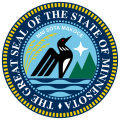| |||||||||||||||||
| |||||||||||||||||
| |||||||||||||||||
The 1886 Minnesota lieutenant gubernatorial election was held on November 2, 1886, in order to elect the lieutenant governor of Minnesota. Republican nominee and incumbent member of the Minnesota Senate Albert E. Rice defeated Democratic nominee and former member of the Minnesota House of Representatives John Frank and Prohibition nominee James P. Pinkham. [1]


